steering FIAT STILO 2006 1.G Owner's Manual
[x] Cancel search | Manufacturer: FIAT, Model Year: 2006, Model line: STILO, Model: FIAT STILO 2006 1.GPages: 274, PDF Size: 4.76 MB
Page 146 of 274
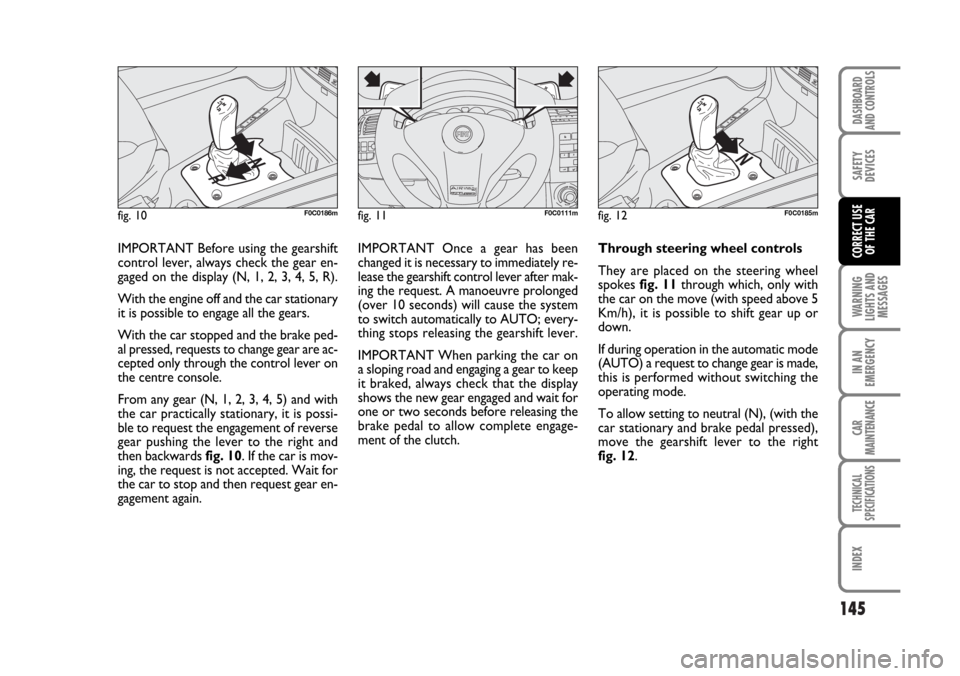
145
WARNING
LIGHTS AND
MESSAGES
IN AN
EMERGENCY
CAR
MAINTENANCE
TECHNICAL
SPECIFICATIONS
INDEX
DASHBOARD
AND CONTROLS
SAFETY
DEVICES
CORRECT USE
OF THE CARIMPORTANT Before using the gearshift
control lever, always check the gear en-
gaged on the display (N, 1, 2, 3, 4, 5, R).
With the engine off and the car stationary
it is possible to engage all the gears.
With the car stopped and the brake ped-
al pressed, requests to change gear are ac-
cepted only through the control lever on
the centre console.
From any gear (N, 1, 2, 3, 4, 5) and with
the car practically stationary, it is possi-
ble to request the engagement of reverse
gear pushing the lever to the right and
then backwards fig. 10. If the car is mov-
ing, the request is not accepted. Wait for
the car to stop and then request gear en-
gagement again.IMPORTANT Once a gear has been
changed it is necessary to immediately re-
lease the gearshift control lever after mak-
ing the request. A manoeuvre prolonged
(over 10 seconds) will cause the system
to switch automatically to AUTO; every-
thing stops releasing the gearshift lever.
IMPORTANT When parking the car on
a sloping road and engaging a gear to keep
it braked, always check that the display
shows the new gear engaged and wait for
one or two seconds before releasing the
brake pedal to allow complete engage-
ment of the clutch.Through steering wheel controls
They are placed on the steering wheel
spokes fig. 11through which, only with
the car on the move (with speed above 5
Km/h), it is possible to shift gear up or
down.
If during operation in the automatic mode
(AUTO) a request to change gear is made,
this is performed without switching the
operating mode.
To allow setting to neutral (N), (with the
car stationary and brake pedal pressed),
move the gearshift lever to the right
fig. 12.
fig. 10F0C0186mfig. 11F0C0111mfig. 12F0C0185m
Page 158 of 274
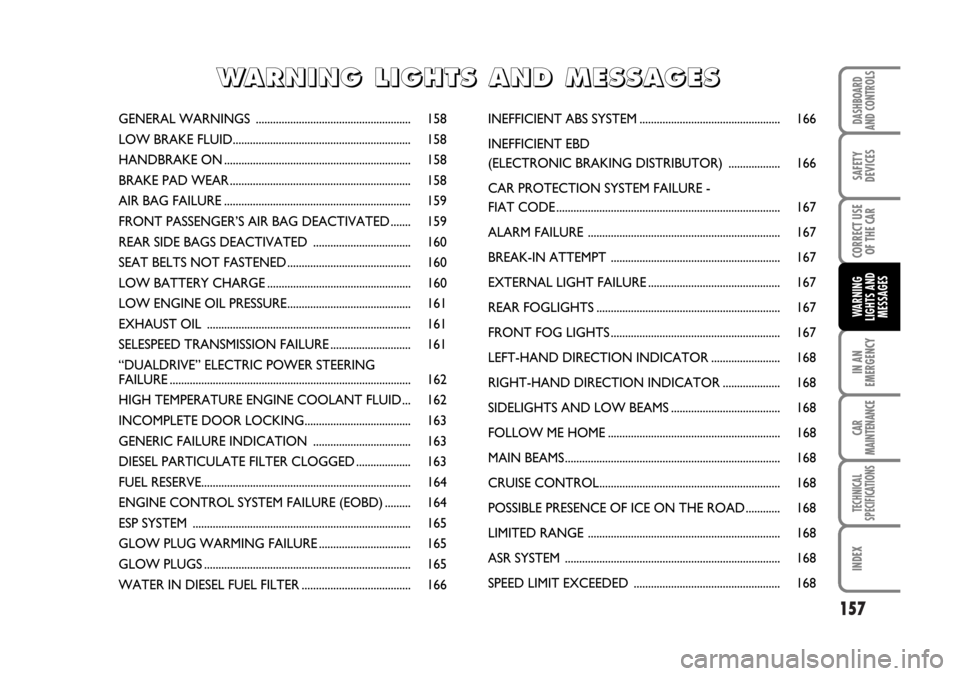
157
IN AN
EMERGENCY
CAR
MAINTENANCE
TECHNICAL
SPECIFICATIONS
INDEX
DASHBOARD
AND CONTROLS
SAFETY
DEVICES
CORRECT USE
OF THE CAR
WARNING
LIGHTS AND
MESSAGES
GENERAL WARNINGS ...................................................... 158
LOW BRAKE FLUID.............................................................. 158
HANDBRAKE ON ................................................................. 158
BRAKE PAD WEAR ............................................................... 158
AIR BAG FAILURE ................................................................. 159
FRONT PASSENGER’S AIR BAG DEACTIVATED ....... 159
REAR SIDE BAGS DEACTIVATED .................................. 160
SEAT BELTS NOT FASTENED ........................................... 160
LOW BATTERY CHARGE .................................................. 160
LOW ENGINE OIL PRESSURE........................................... 161
EXHAUST OIL ....................................................................... 161
SELESPEED TRANSMISSION FAILURE ............................ 161
“DUALDRIVE” ELECTRIC POWER STEERING
FAILURE .................................................................................... 162
HIGH TEMPERATURE ENGINE COOLANT FLUID ... 162
INCOMPLETE DOOR LOCKING..................................... 163
GENERIC FAILURE INDICATION .................................. 163
DIESEL PARTICULATE FILTER CLOGGED ................... 163
FUEL RESERVE......................................................................... 164
ENGINE CONTROL SYSTEM FAILURE (EOBD) ......... 164
ESP SYSTEM ............................................................................ 165
GLOW PLUG WARMING FAILURE ................................ 165
GLOW PLUGS ........................................................................ 165
WATER IN DIESEL FUEL FILTER ...................................... 166INEFFICIENT ABS SYSTEM ................................................. 166
INEFFICIENT EBD
(ELECTRONIC BRAKING DISTRIBUTOR) .................. 166
CAR PROTECTION SYSTEM FAILURE -
FIAT CODE .............................................................................. 167
ALARM FAILURE ................................................................... 167
BREAK-IN ATTEMPT ........................................................... 167
EXTERNAL LIGHT FAILURE .............................................. 167
REAR FOGLIGHTS ................................................................ 167
FRONT FOG LIGHTS ........................................................... 167
LEFT-HAND DIRECTION INDICATOR ........................ 168
RIGHT-HAND DIRECTION INDICATOR .................... 168
SIDELIGHTS AND LOW BEAMS ...................................... 168
FOLLOW ME HOME ............................................................ 168
MAIN BEAMS ........................................................................... 168
CRUISE CONTROL............................................................... 168
POSSIBLE PRESENCE OF ICE ON THE ROAD ............ 168
LIMITED RANGE ................................................................... 168
ASR SYSTEM ........................................................................... 168
SPEED LIMIT EXCEEDED ................................................... 168
W W
A A
R R
N N
I I
N N
G G
L L
I I
G G
H H
T T
S S
A A
N N
D D
M M
E E
S S
S S
A A
G G
E E
S S
Page 163 of 274
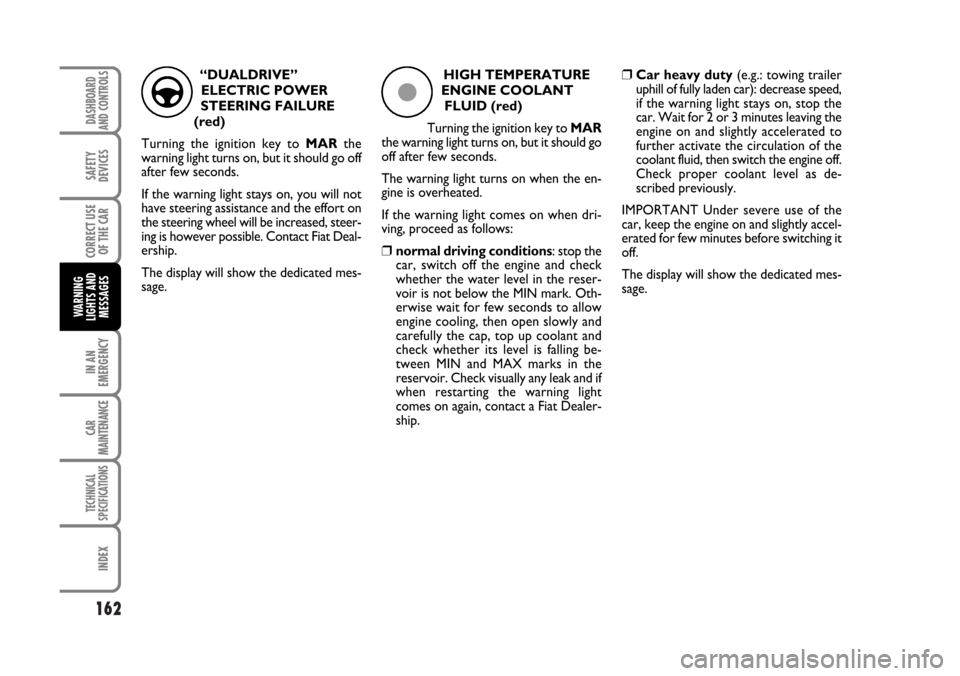
162
IN AN
EMERGENCY
CAR
MAINTENANCE
TECHNICAL
SPECIFICATIONS
INDEX
DASHBOARD
AND CONTROLS
SAFETY
DEVICES
CORRECT USE
OF THE CAR
WARNING
LIGHTS AND
MESSAGES
“DUALDRIVE”
ELECTRIC POWER
STEERING FAILURE
(red)
Turning the ignition key to MARthe
warning light turns on, but it should go off
after few seconds.
If the warning light stays on, you will not
have steering assistance and the effort on
the steering wheel will be increased, steer-
ing is however possible. Contact Fiat Deal-
ership.
The display will show the dedicated mes-
sage.HIGH TEMPERATURE
ENGINE COOLANT
FLUID (red)
Turning the ignition key to MAR
the warning light turns on, but it should go
off after few seconds.
The warning light turns on when the en-
gine is overheated.
If the warning light comes on when dri-
ving, proceed as follows:
❒normal driving conditions: stop the
car, switch off the engine and check
whether the water level in the reser-
voir is not below the MIN mark. Oth-
erwise wait for few seconds to allow
engine cooling, then open slowly and
carefully the cap, top up coolant and
check whether its level is falling be-
tween MIN and MAX marks in the
reservoir. Check visually any leak and if
when restarting the warning light
comes on again, contact a Fiat Dealer-
ship.
❒Car heavy duty(e.g.: towing trailer
uphill of fully laden car): decrease speed,
if the warning light stays on, stop the
car. Wait for 2 or 3 minutes leaving the
engine on and slightly accelerated to
further activate the circulation of the
coolant fluid, then switch the engine off.
Check proper coolant level as de-
scribed previously.
IMPORTANT Under severe use of the
car, keep the engine on and slightly accel-
erated for few minutes before switching it
off.
The display will show the dedicated mes-
sage.
gç
Page 171 of 274
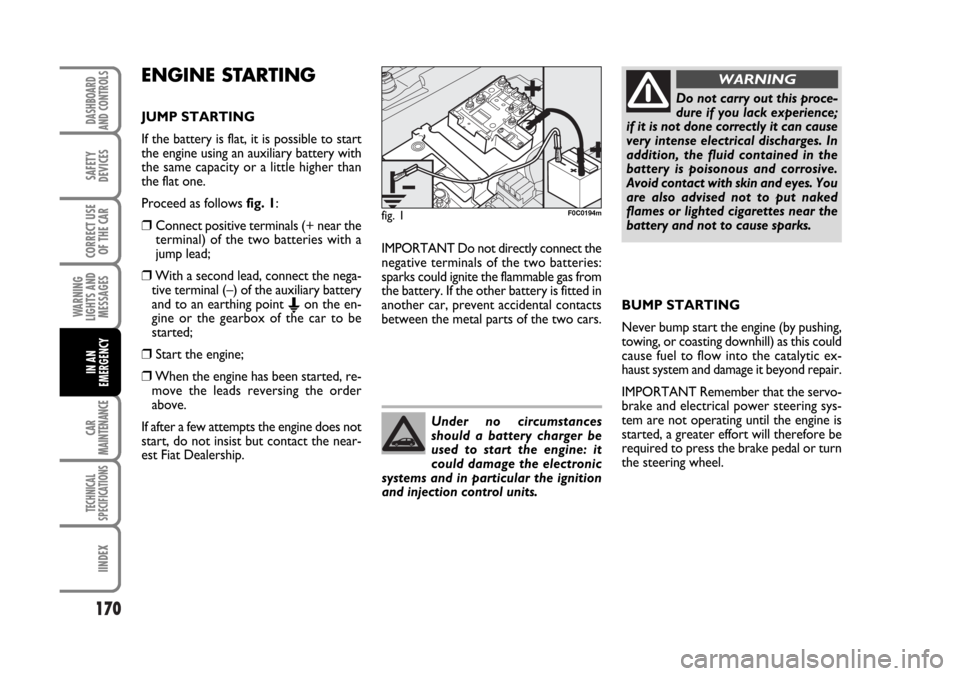
170
WARNING
LIGHTS AND
MESSAGES
CAR
MAINTENANCE
TECHNICAL
SPECIFICATIONS
IINDEX
DASHBOARD
AND CONTROLS
SAFETY
DEVICES
CORRECT USE
OF THE CAR
IN AN
EMERGENCY
ENGINE STARTING
JUMP STARTING
If the battery is flat, it is possible to start
the engine using an auxiliary battery with
the same capacity or a little higher than
the flat one.
Proceed as follows fig. 1:
❒Connect positive terminals (+ near the
terminal) of the two batteries with a
jump lead;
❒With a second lead, connect the nega-
tive terminal (–) of the auxiliary battery
and to an earthing point
Eon the en-
gine or the gearbox of the car to be
started;
❒Start the engine;
❒When the engine has been started, re-
move the leads reversing the order
above.
If after a few attempts the engine does not
start, do not insist but contact the near-
est Fiat Dealership.IMPORTANT Do not directly connect the
negative terminals of the two batteries:
sparks could ignite the flammable gas from
the battery. If the other battery is fitted in
another car, prevent accidental contacts
between the metal parts of the two cars.BUMP STARTING
Never bump start the engine (by pushing,
towing, or coasting downhill) as this could
cause fuel to flow into the catalytic ex-
haust system and damage it beyond repair.
IMPORTANT Remember that the servo-
brake and electrical power steering sys-
tem are not operating until the engine is
started, a greater effort will therefore be
required to press the brake pedal or turn
the steering wheel.
fig. 1F0C0194m
Under no circumstances
should a battery charger be
used to start the engine: it
could damage the electronic
systems and in particular the ignition
and injection control units.
Do not carry out this proce-
dure if you lack experience;
if it is not done correctly it can cause
very intense electrical discharges. In
addition, the fluid contained in the
battery is poisonous and corrosive.
Avoid contact with skin and eyes. You
are also advised not to put naked
flames or lighted cigarettes near the
battery and not to cause sparks.
WARNING
Page 203 of 274
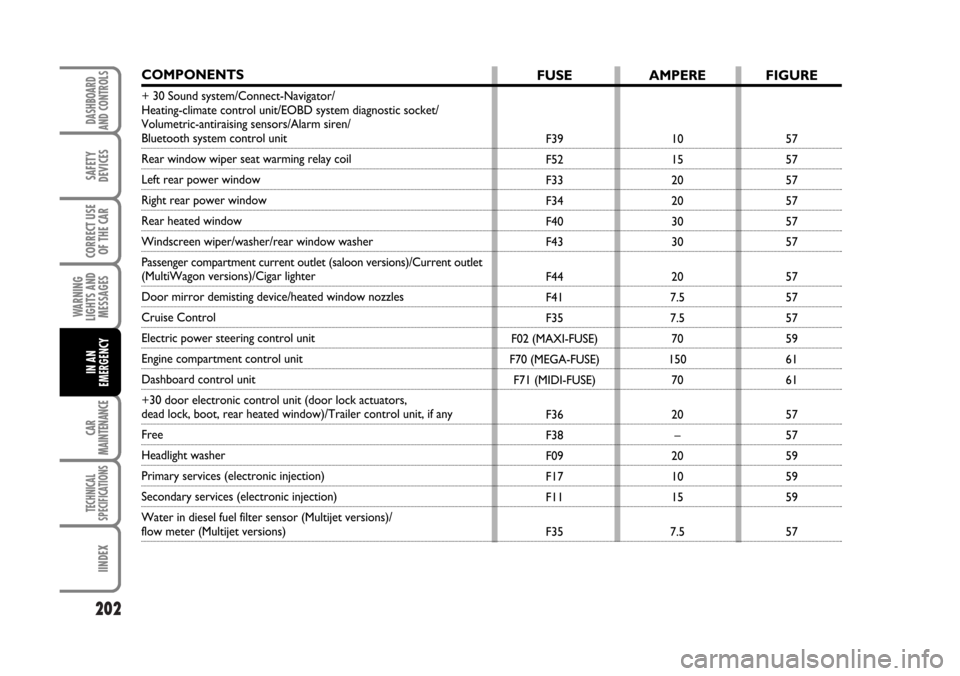
202
WARNING
LIGHTS AND
MESSAGES
CAR
MAINTENANCE
TECHNICAL
SPECIFICATIONS
IINDEX
DASHBOARD
AND CONTROLS
SAFETY
DEVICES
CORRECT USE
OF THE CAR
IN AN
EMERGENCY
COMPONENTS
+ 30 Sound system/Connect-Navigator/
Heating-climate control unit/EOBD system diagnostic socket/
Volumetric-antiraising sensors/Alarm siren/
Bluetooth system control unit
Rear window wiper seat warming relay coil
Left rear power window
Right rear power window
Rear heated window
Windscreen wiper/washer/rear window washer
Passenger compartment current outlet (saloon versions)/Current outlet
(MultiWagon versions)/Cigar lighter
Door mirror demisting device/heated window nozzles
Cruise Control
Electric power steering control unit
Engine compartment control unit
Dashboard control unit
+30 door electronic control unit (door lock actuators,
dead lock, boot, rear heated window)/Trailer control unit, if any
Free
Headlight washer
Primary services (electronic injection)
Secondary services (electronic injection)
Water in diesel fuel filter sensor (Multijet versions)/
flow meter (Multijet versions)
FUSE
F39
F52
F33
F34
F40
F43
F44
F41
F35
F02 (MAXI-FUSE)
F70 (MEGA-FUSE)
F71 (MIDI-FUSE)
F36
F38
F09
F17
F11
F35
AMPERE
10
15
20
20
30
30
20
7.5
7.5
70
150
70
20
–
20
10
15
7.5
FIGURE
57
57
57
57
57
57
57
57
57
59
61
61
57
57
59
59
59
57
Page 205 of 274
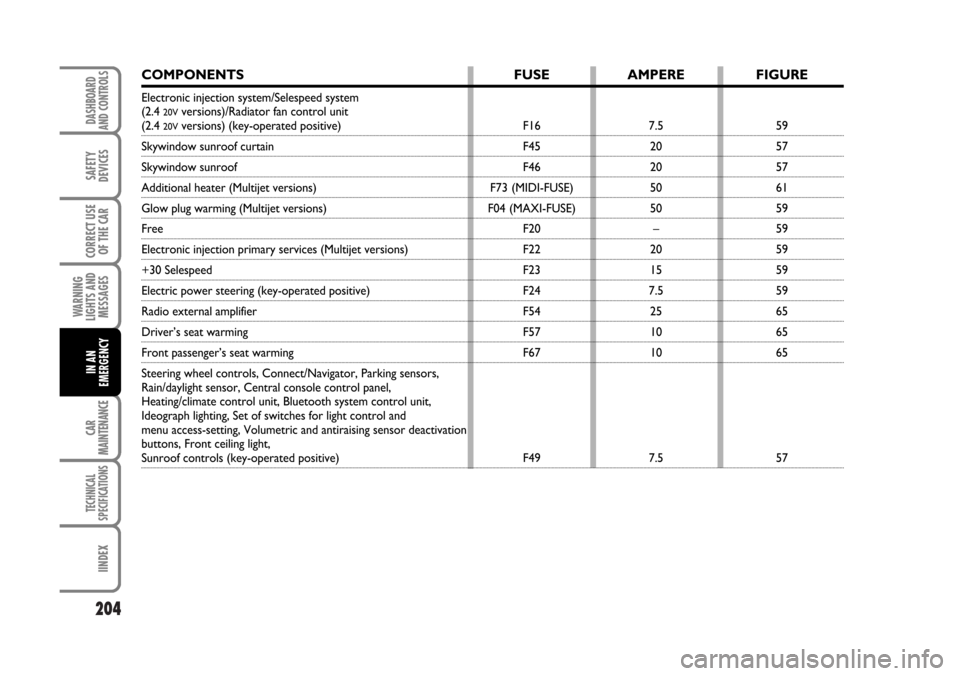
204
WARNING
LIGHTS AND
MESSAGES
CAR
MAINTENANCE
TECHNICAL
SPECIFICATIONS
IINDEX
DASHBOARD
AND CONTROLS
SAFETY
DEVICES
CORRECT USE
OF THE CAR
IN AN
EMERGENCY
COMPONENTS
Electronic injection system/Selespeed system
(2.4 20Vversions)/Radiator fan control unit(2.4 20Vversions) (key-operated positive)
Skywindow sunroof curtain
Skywindow sunroof
Additional heater (Multijet versions)
Glow plug warming (Multijet versions)
Free
Electronic injection primary services (Multijet versions)
+30 Selespeed
Electric power steering (key-operated positive)
Radio external amplifier
Driver’s seat warming
Front passenger’s seat warming
Steering wheel controls, Connect/Navigator, Parking sensors,
Rain/daylight sensor, Central console control panel,
Heating/climate control unit, Bluetooth system control unit,
Ideograph lighting, Set of switches for light control and
menu access-setting, Volumetric and antiraising sensor deactivation
buttons, Front ceiling light,
Sunroof controls (key-operated positive)
FUSE
F16
F45
F46
F73 (MIDI-FUSE)
F04 (MAXI-FUSE)
F20
F22
F23
F24
F54
F57
F67
F49
AMPERE
7.5
20
20
50
50
–
20
15
7.5
25
10
10
7.5
FIGURE
59
57
57
61
59
59
59
59
59
65
65
65
57
Page 208 of 274
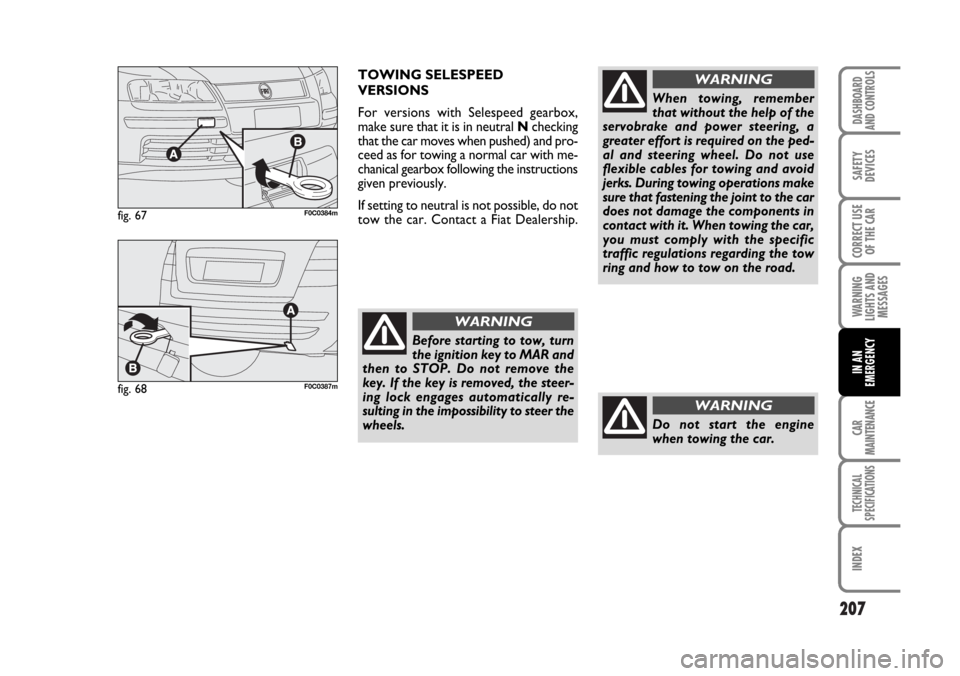
207
WARNING
LIGHTS AND
MESSAGES
CAR
MAINTENANCE
TECHNICAL
SPECIFICATIONS
INDEX
DASHBOARD
AND CONTROLS
SAFETY
DEVICES
CORRECT USE
OF THE CAR
IN AN
EMERGENCY
fig. 67F0C0384m
fig. 68F0C0387m
TOWING SELESPEED
VERSIONS
For versions with Selespeed gearbox,
make sure that it is in neutral Nchecking
that the car moves when pushed) and pro-
ceed as for towing a normal car with me-
chanical gearbox following the instructions
given previously.
If setting to neutral is not possible, do not
tow the car. Contact a Fiat Dealership.
Before starting to tow, turn
the ignition key to MAR and
then to STOP. Do not remove the
key. If the key is removed, the steer-
ing lock engages automatically re-
sulting in the impossibility to steer the
wheels.
WARNING
When towing, remember
that without the help of the
servobrake and power steering, a
greater effort is required on the ped-
al and steering wheel. Do not use
flexible cables for towing and avoid
jerks. During towing operations make
sure that fastening the joint to the car
does not damage the components in
contact with it. When towing the car,
you must comply with the specific
traffic regulations regarding the tow
ring and how to tow on the road.
WARNING
Do not start the engine
when towing the car.
WARNING
Page 230 of 274
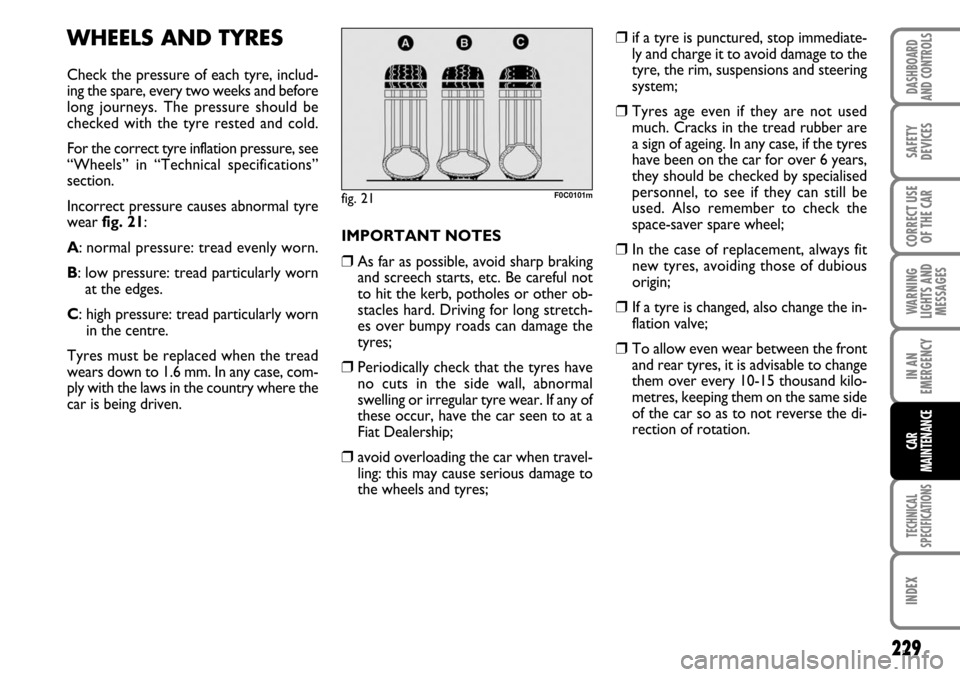
229
WARNING
LIGHTS AND
MESSAGES
TECHNICAL
SPECIFICATIONS
INDEX
DASHBOARD
AND CONTROLS
SAFETY
DEVICES
CORRECT USE
OF THE CAR
IN AN
EMERGENCY
CAR
MAINTENANCE
WHEELS AND TYRES
Check the pressure of each tyre, includ-
ing the spare, every two weeks and before
long journeys. The pressure should be
checked with the tyre rested and cold.
For the correct tyre inflation pressure, see
“Wheels” in “Technical specifications”
section.
Incorrect pressure causes abnormal tyre
wearfig. 21:
A: normal pressure: tread evenly worn.
B: low pressure: tread particularly worn
at the edges.
C: high pressure: tread particularly worn
in the centre.
Tyres must be replaced when the tread
wears down to 1.6 mm. In any case, com-
ply with the laws in the country where the
car is being driven.IMPORTANT NOTES
❒As far as possible, avoid sharp braking
and screech starts, etc. Be careful not
to hit the kerb, potholes or other ob-
stacles hard. Driving for long stretch-
es over bumpy roads can damage the
tyres;
❒Periodically check that the tyres have
no cuts in the side wall, abnormal
swelling or irregular tyre wear. If any of
these occur, have the car seen to at a
Fiat Dealership;
❒avoid overloading the car when travel-
ling: this may cause serious damage to
the wheels and tyres;
fig. 21F0C0101m
❒if a tyre is punctured, stop immediate-
ly and charge it to avoid damage to the
tyre, the rim, suspensions and steering
system;
❒Tyres age even if they are not used
much. Cracks in the tread rubber are
a sign of ageing. In any case, if the tyres
have been on the car for over 6 years,
they should be checked by specialised
personnel, to see if they can still be
used. Also remember to check the
space-saver spare wheel;
❒ In the case of replacement, always fit
new tyres, avoiding those of dubious
origin;
❒ If a tyre is changed, also change the in-
flation valve;
❒To allow even wear between the front
and rear tyres, it is advisable to change
them over every 10-15 thousand kilo-
metres, keeping them on the same side
of the car so as to not reverse the di-
rection of rotation.
Page 237 of 274
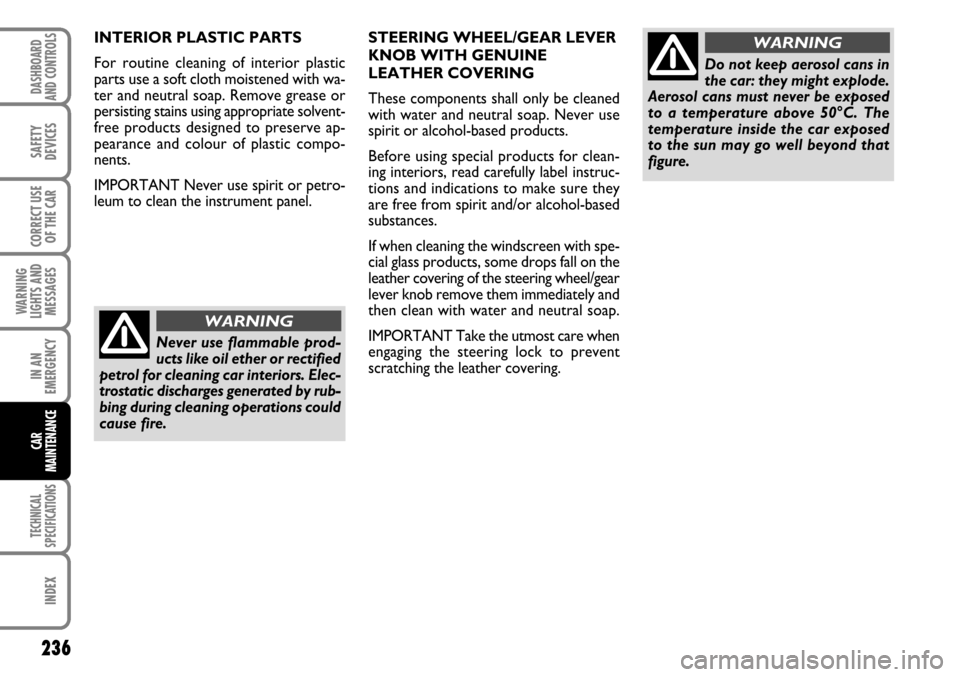
236
WARNING
LIGHTS AND
MESSAGES
TECHNICAL
SPECIFICATIONS
INDEX
DASHBOARD
AND CONTROLS
SAFETY
DEVICES
CORRECT USE
OF THE CAR
IN AN
EMERGENCY
CAR
MAINTENANCE
INTERIOR PLASTIC PARTS
For routine cleaning of interior plastic
parts use a soft cloth moistened with wa-
ter and neutral soap. Remove grease or
persisting stains using appropriate solvent-
free products designed to preserve ap-
pearance and colour of plastic compo-
nents.
IMPORTANT Never use spirit or petro-
leum to clean the instrument panel.STEERING WHEEL/GEAR LEVER
KNOB WITH GENUINE
LEATHER COVERING
These components shall only be cleaned
with water and neutral soap. Never use
spirit or alcohol-based products.
Before using special products for clean-
ing interiors, read carefully label instruc-
tions and indications to make sure they
are free from spirit and/or alcohol-based
substances.
If when cleaning the windscreen with spe-
cial glass products, some drops fall on the
leather covering of the steering wheel/gear
lever knob remove them immediately and
then clean with water and neutral soap.
IMPORTANT Take the utmost care when
engaging the steering lock to prevent
scratching the leather covering.
Do not keep aerosol cans in
the car: they might explode.
Aerosol cans must never be exposed
to a temperature above 50°C. The
temperature inside the car exposed
to the sun may go well beyond that
figure.
WARNING
Never use flammable prod-
ucts like oil ether or rectified
petrol for cleaning car interiors. Elec-
trostatic discharges generated by rub-
bing during cleaning operations could
cause fire.
WARNING
Page 238 of 274

237
WARNING
LIGHTS AND
MESSAGES
INDEX
DASHBOARD
AND CONTROLS
SAFETY
DEVICES
CORRECT USE
OF THE CAR
IN AN
EMERGENCY
CAR
MAINTENANCE
TECHNICAL
SPECIFICATIONS
IDENTIFICATION DATA ................................................... 238
ENGINE CODES - BODYWORK VERSIONS .............. 240
ENGINE .................................................................................... 241
FUEL FEED/IGNITION ........................................................ 243
TRANSMISSION .................................................................... 243
BRAKES ..................................................................................... 244
SUSPENSIONS......................................................................... 244
STEERING ................................................................................. 244
WHEELS .................................................................................... 245
DIMENSIONS .......................................................................... 250
PERFORMANCE ..................................................................... 253
WEIGHTS ................................................................................. 254
CAPACITIES ........................................................................... 257
FLUIDS AND LUBRICANTS ............................................... 259
FUEL CONSUMPTION ........................................................ 261
CO
2EMISSIONS .................................................................... 263
T T
E E
C C
H H
N N
I I
C C
A A
L L
S S
P P
E E
C C
I I
F F
I I
C C
A A
T T
I I
O O
N N
S S